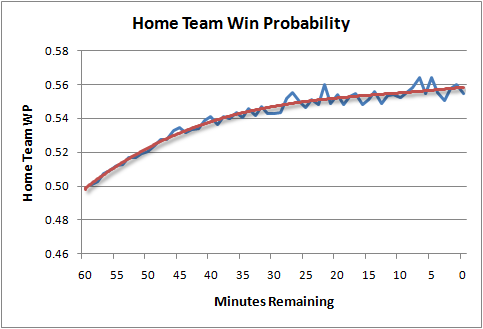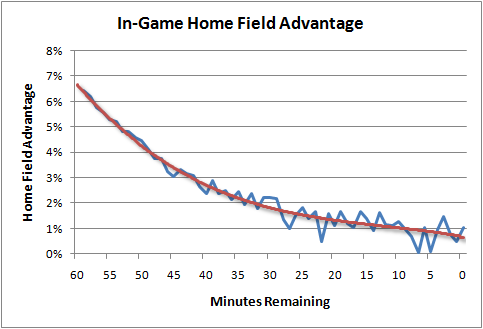 Last season I discovered something interesting about home field advantage (HFA) in NFL games. It decreases as the game goes on. In terms of points scored by quarter, home teams have the biggest advantage in the 1st quarter, and then their advantage disappears by the end of the game. By the end of regulation, home teams and visiting teams perform equally well.
Last season I discovered something interesting about home field advantage (HFA) in NFL games. It decreases as the game goes on. In terms of points scored by quarter, home teams have the biggest advantage in the 1st quarter, and then their advantage disappears by the end of the game. By the end of regulation, home teams and visiting teams perform equally well.
Although it’s clear that home teams perform better during a game, at least in terms of points scored, it’s not clear exactly how this translates into an increased chance of winning minute by minute. From simple win-loss records, all we know that at the outset of a game the home generally team ultimately has about a 56.5% chance of winning.
So there are (at least) two mechanisms at work. First is the decrease in performance advantage for the home team as the game goes on that I discussed above. Perhaps fatigue neutralizes the home team's edge, or perhaps it's visitor acclimation to a hostile, unfamiliar environment. Second, as the game clock ticks down, there is less time for the home team to capitalize on its advantage. By the end of the game the scoreboard doesn’t care which team is the home team and which is the visitor. A 1-point lead is good enough to win, period. So it’s a complicated thing to model. We just can’t add 6.5% to the win probability (WP) for the home team throughout the game.
But I think I’ve cracked it. Using the WP model, which does not consider HFA, I can chart the average probability that the home team will win as the game goes on. It begins at 50% and by the end of the game it’s 56.5% (which I'll call a "6.5%" advantage).
But we know that 6.5% advantage really exists as early as the first kickoff. It’s just that the model is “learning” and discovering that advantage as it actually accrues over the course of the game. So the shape of that curve is the shape of the curve of actual HFA, just in reverse.
Starting with a 6.5% advantage at kickoff, and following the shape of the curve, we see the real, no kidding, actual HFA as the game goes on. This isn’t HFA in terms of yards per play, first downs, or points scored, or in terms of anything except the probability of winning.
The HFA equation is:
Where t is the time in minutes remaining in a game.
This now enables me to feed the strength of the advantage back into the win probability model to properly adjust for HFA. I would have to adjust the home field-agnostic WP with these values logistically (using the log of the odds ratios). This is because HFA would decrease in importance as one team or the other builds a large lead. HFA doesn’t really matter if a team has a 28-0 lead at halftime.
I've intended to include HFA into the WP model for a while, but just didn't know exactly how it declined through the course of the game. Now I know. Thanks to Ian for an insightful comment that got my wheels turning.
- Home
- win probability
- In-Game Home Field Advantage
In-Game Home Field Advantage
By
Brian Burke
%HFA = (-4E-05)t3 + 0.0056t2 - 0.304t + 6.98
published on 7/13/2009
in
home field advantage,
research,
win probability
Subscribe to:
Post Comments (Atom)








Are you sure this is right? It seems like HFA would have a near-constant effect on scoring likelihood, but the ratio of the information it provides to other information would decrease as the game goes on (0-0 before kickoff tells you nothing, 37-3 with 2 minutes left in the 4th tells you everything), thus causing the decrease.
Yes. Check out the article linked-to at the top of this post. The same effect exists in the NBA. I believe the Pro-Football-Reference guys independently found the same thing in the NFL.
I read the other article, and I'm not sure how you can be sure that HFA decreases as the game goes on. Couldn't it be that teams change their style of play based on the score? You do include a chart for when teams are tied, but, as you say, a home team that's tied in the fourth quarter is probably the worse team ... and the fourth quarter is always weird in other ways.
I wonder if this effect also holds in baseball ... the evidence in MLB is that there's no such thing as clutch hitting, so if there's a natural tendency for home and road teams to converge late in the game, teams should score a more equal number of runs in the 8th inning than (say) in the 4th. You'd have to adjust for lineup, though.
Actually, if you averaged all the teams, lineups would probably even out.
Yes, that's the one reason I'm confident--the effect appears to hold even when the score is tied. But, as you point out, a home team that's tied in the 4th quarter is probably the weaker team. I wonder how big an effect that would have. There is so much random noise in any one game (good teams can be tied with bad teams, and vice-versa).
These two posts at PFR have some interesting things about how the decreasing HFA effect may be due to environmental familiarity.
http://www.pro-football-reference.com/blog/?p=1208
http://www.pro-football-reference.com/blog/?p=1227
But this third post might be what ultimately convinces. In it, Doug Drinen has a regression of team win probability holding for team strength. Holding all else equal, the coefficient for home field diminishes for each quarter.
http://www.pro-football-reference.com/blog/?p=691
One of the reasons I have a lot of faith in that post, and what it says about HFA, is that the HFA coefficient was incidental to the point of his study. Doug wasn't really investigating HFA at all.
In any case, the main point of my own post here was to figure out how to empirically model HFA as it's observed. I can't say that these results confirm any of the speculation about why it happens.
The inherent problem with this analysis is it only applies if the teams are even. The 56.5 chance of winning is the avg. over the whole league. Therefore if 2 even teams played the one at home would therefore have 56.5% chance of winning. You have to incorporate the % chance of winning for each team to have accurate reading in one particular game. You can get this from the odds (subtracting out juice) or your model and then factor that into each individual game.
But doesn't Doug's third post just show that the less time you have left in the game, the less time the HFA has to come out? That's already known: if football games were 600 minutes instead of 60, HFA would be much higher. So if you're talking about (the last) 15 minutes instead of 60, the observed effect of HFA should be lower.
Yeah, that's true. I guess we'd need the same regression but with points instead of win probability as the dependent variable.
Dave-I agree with what you say, but a generalized model of NFL football is very useful in many ways.
If you look just at games where the home side goes into the game as the underdog,you don't find this effect.
Since 1989,home underdogs generally score 45% of the points in the first quarter and 46% of points in the fourth.So they actually do best in the 4th.
Divisional home dogs show an even more extreme split.They gather 47.3% of the 4th quarter points,but only 43% of first quarter ones.
Home favourites do show the progression you report.They score 60.5% of 1st quarter points,58.3% of 2nd,56.9% of 3rd and 55.3% of 4th.
This means when you look at the league as a whole the progression exhibited by the more numerous home favourites swamps that shown by the home underdogs and it appears that home advantage declines with time.
I think the effect is most likely driven by game position.The better side more often aggressively gathers points and then moves to a more passive clock control mode.
To say that hfa declines throughout the game by looking at points scored/allowed you have to be sure that both teams are playing at the same competitive level through all four quarters.....and you carn't always be sure of that.
If you look at games that you expect to be low scoring,there's a reduced chance that the better side can build up a lead they're comfortable with.Therefore,its less likely that one team will play a passive role late in the game and in these type of matchups the proportion of points scored by home and away sides remains relatively constant over all 4 quarters.
Interesting. Thanks, Denis. My 2nd graph in the linked-to article bears this out. The effect is only present when home teams are behind.
Hi Brian,
You can further demonstrate the importance of the game position by looking at the proportion of points accrued by home favourites in the final two quarters in different situations.
When tied at the half home favs average 59% of the 3rd quarter points and 57.4% in the 4th.(On average they get ahead in the 3rd and they keep the pressure on in the 4th).
When leading by a TD or more at the half they average 56.8% of 3rd quarter points and 54% of 4th.
Lead by 2 or more TDs and they get 55.5% of 3rd quarter points and just 52% of 4th.(They keep their opponents at arms length in the 3rd and coast through the 4th).
So the extent of their average supremacy and the amount that it tails off appears to depend on the size of their half time lead and you get the decline in scoring per quarter that's observed in a league wide sample.
However,if instead they trail by one or more TDs at the half home favs average 58% of 3rd quarter points and they up this to 59.8% in the 4th.
Trail by 2 or more TDs and they score 59.6% of 3rd quarter points and 62.1% in the 4th.(They try to assert their superiority in the 3rd and such was the size of the half time deficit they have to up their game even more in the 4th to either protect or create a lead).
And we see a reversal of the more commonly seen scoring trend by quarter.
I know this is old, but I hope someone responds. I just read the 2007 article about why passing is relatively more important for road teams. One theory offered up, but not defended, was that road teams have to come from behind more, a situation in which passing is more useful.
Could this large home-team 1st half advantage explain this phenomenon? Visiting teams dispraportionately fall behind early, and thus need good passing games to catch up.